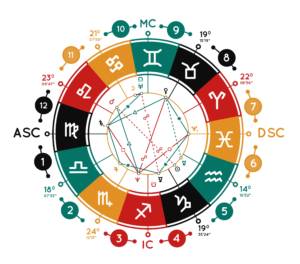Where Do Your Planets Live? Astrology’s Horoscope Houses

Astrology is more than just zodiac signs. Horoscope house systems can map life concerns to specific celestial regions.
When many people learn about astrology, they focus mostly on the signs in which planets are positioned. Yet for professional astrologers and many enthusiasts, there’s much more to a person’s birth chart than just zodiac signs. With collections of unique energies and traits, horoscope houses can reveal much more information about an individual’s personality and life path.
A Quick History of Horoscope Houses
The Babylonians had developed a form of horoscopic astrology for drawing up natal charts by the end of the Iron Age. Astrodienst explains that the ancient Greeks were among the first to use astrological house systems. Kepler College adds that more than 20 house systems exist, each using a different approach to divide the natal chart. Today, the most popular ones are the Placidus, Koch, Equal House and Whole Sign systems. Each house represents a specific area of a person’s life.
Drawing the Houses on a Birth Chart
Birth charts are typically drawn as circles, each with two concentric rings on the perimeter. The 12 zodiac signs are placed on the outer ring, but horoscope houses are mapped on the inner ring. Astrologers use the ascendant, or rising sign, to determine the first house’s placement.
Finding an ascendant requires the person’s exact date, time and place of birth. Remember that the birth chart contains a snapshot of planet and point positions in the sky when an individual is born. The ascendant on the left side represents the eastern horizon, and the descendant on the right side signifies the western horizon. While the horizons are fixed, the zodiac sign sitting at that point shifts as the earth rotates.
Horoscope Houses and Their Meanings
Astrostyle offers a quick guide to the 12 horoscope houses. If you draw a straight line between the ascendant and descendant points on a birth chart, this splits the chart horizontally into two halves. The six horoscope houses below this axis represent personal concerns:
- First house: self, beginnings, identity, and appearances
- Second house: money, material concerns, and self-esteem
- Third house: the mind, communication, siblings, and education
- Fourth house: privacy, security, self-care, and nurturing
- Fifth house: romance, love, creativity, self-expression
- Sixth house: health, fitness, work habits, and service
Meanwhile, the six above the axis are referred to as interpersonal houses. This makes sense since the birth chart area below the axis denotes the night and the area above symbolizes the day. What’s personal remains below the surface, while social aspects are more readily seen by others in the light. Astrostyle briefly describes the six interpersonal houses:
- Seventh house: relationships, partnerships, contracts, and marriage
- Eighth house: transformation, sexuality, inheritances, and shared finances
- Ninth house: travel, higher education, wisdom, and philosophy
- Tenth house: career, long-term goals, status, and reputation
- Eleventh house: social awareness, friends, technology, and the future
- Twelfth house: endings, closure, death, and spirituality
The Blending of Planet and House Energies
Just as planet and zodiac sign energies combine, the same is true of planet and house energies. Each house has a ruling sign, so the sign’s and house’s traits tend to be similar. To understand how this works, consider a planet-house placement with compatible energies: a natal Sun in the fifth house. The Sun is Leo’s ruling planet, and Leo rules the fifth house. Self-expression, creativity, and romance would probably feel natural to a person with this placement.
Planet-house placements can also bring together less compatible influences. One example is restriction-minded Saturn appearing in moon-ruled Cancer’s fourth house. Saturn’s limiting energies could impact familial love and nurturing. A person with this placement may experience a childhood that seems cold and unloving.
Celestial Movements and Divination
Astrology is more than zodiac signs. Horoscope house systems map life concerns to specific celestial regions. Using planetary positions in these houses, astrologers try to make sense of how these energies impact our personalities and lives.

